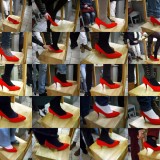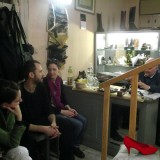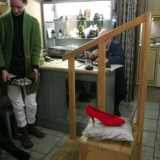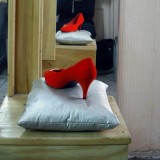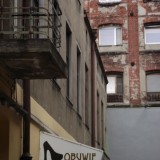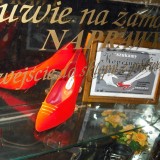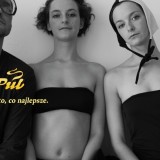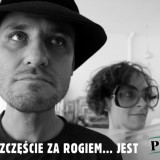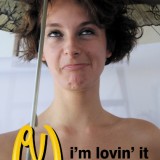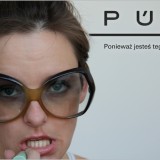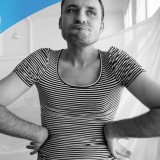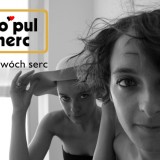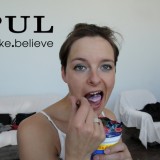Informal PUL Group
The name of the art PUL Group comes from the first letters of the first names of its founders. It consists of twin sisters – Paulina and Urszula Korwin Kochanowska and Ludwik (Dariusz Gwidon Ludwisiak). Paulina and Ludwik graduated from the Department of Visual Education (currently the Department of Visual Arts) in the Adademy of Fine arts in £ódľ. Urszula is a graduate of the University of Arts, London Central Saint Martin’s College of Art and Design. The group emerged in 2010, as the artists wrote as a result of a fierce after-art-opening discussion. With time and the amount of alcohol drunk, the artistic intention was set. The existence of the group became a fact.
The group bases its activity on photography and elements of graphic design, which in this case do not have any practical aim. Their works, which use the style of advertisements are at the same time a subtle and ironic critique of the mechanisms which rule the surrounding reality. Their posters were presented during various exhibitions and competitions, among others was the 10th International Poster Triennial in Toyama, Japan and the 2nd International Poster Triennial in Vienna (a series Will I be Missed?).
In 2011 during the exhibition entitled PUL not for idiots in the Gallery of the Visual Arts Department in the Academy of Fine Arts in £ódľ, the group decided to face the problem of the perception of advertisements which show up on their billboards (so called PULboards). The artists took a few well known advertising slogans from large companies out of their original context and moved them into a gallery space and directed new slogans to the new audience. On posters, the original slogans or brandnames were replaced with the name of the group. The word PUL “pretended” logos of various companies. So we read “Thank God, there is PUL round the corner”, “To PUL herc”, “PUL, serve the best”. The ads were supplemented with altered photographs taken by the group which showed its members. The whole effect was a specific advertisement by the group. These kind of activities also show up in subsequent projects. So in some works they use the manner of well known commercial companies to advertise their products in the public space (billboards, poster, TV ad) and thereby question their primary sense. At the same time on the one hand they make a dialog with the original and on the other – a game which is humorous for the audience.
We assume, that all of us are bombarded and entertained by visual advertisements, which sometimes do not take any time at all to verify their point. Visual adverts influence our mood and feelings of satisfaction. The group tries to use this phenomenon for their own aims. The artists do not want to fight with the advertisements. The fact that they notice their omnipresence which sometimes (contrary to its aim) leads to a specific callousness towards its slogans, is their artistic goal.
Since the artists who make up the group started to act together, they also began to make art actions, which often contain an element of humour, the grotesque or a kind of an artistic intervention in reality. The actions in the beginning occurred accidentally like in case of the “performance for camera” by the £ódľ Kaliska Group, which had new media origins or the actions of the Gruppa Group or the £adnie Group – formations consisting mainly out of artist who were painters. Contrary to the individual actions of performance artists, the actions of PUL are devised by the collective group. These kind of actions have their origin in happenings.
In 2011-2013 the group participated in three subsequent editions of a project entitled “Good and Beauty” presented in the “relics” of communist £ódľ in such locations as milk bars and workshops. In 2011 in the Anna Bar, the artists turned bar tables into giant candies and in 2012 they decided to find a contemporary Cinderella. The action took place in the shoemaker’s workshop of Kazimierz Sumera at 78 Piotrkowska St. which operated through three generations, and where people of both sexes could try on a shoe. As we read in the text by the artists: Awards were: “a Prince, some good looking shoes or of course half of the PUL Kingdom”. The shoe had a non-typical size (41), but the artists were able to find three Cinderellas. In 2013 in the Manhattan Gallery in £ódľ they participated in a performance art evening and released 21 spinning tops (in Polish a top and a fart is the same word). The artists assimilated with the audience and made the action together, blurring the traditional border between a viewer and artist.
A project by the art PUL group which was associated with the context of £ódľ was a work from the series Will I Be missed?. This project referred to a unique complex of 19th and 20th century factory buildings and houses which fell into ruin and were demolished systematically. The artists prepared a neon sign saying “Will I Be Missed?” and then by using a photomontage technique they placed the sign on photographs of demolished buildings. They also made a digital map of disappearing buildings and prepared “sentimental in style” postcards with the photos of objects which deteriorate. These projects were presented in various forms: as postcards at the exhibition (Photo Café 102), a project for the competition (Photofestival 2012), and a film presented during the exhibition Art Object Registration 4 during the Art & Documentation Festival.
The project Will I Be Missed? consisted of a few elements, which all referred to the one slogan. Similarly to advertising strategies, in which one product is advertised in many ways. Here the fixed element was not a brand or a product, but a slogan, which became a pretext to create various visual elements. As part of the workshops entitled “The Meet Culture” (1 and 2 in 2011), PUL presented a pig, whose spine was a three-metre neon sign “Will I be missed?”. The paws, tail and head all made of cardboard were sticking out of it. Pig-PUL-neon was a spine of a pig – a farm animal. The text in the form of a neon sign addressed to the consumer poses the question, if the subject of a routinely consumed meal evokes its memory, can one have hiccups after it?
The next works from the series were postcards which referred to the ones from communist times which one could buy in a kiosk and which showed pets. It was a series of images of farm animals that all have a spine with the sentence “Will I Be Missed?”. Based on that idea, there emerged works in a large format (a poster: the free-range art group, or graphics Pig-Pul, Sheep-Pul, Cow-Pul and others presented in Vienna in 2013 during an International Graphics Triennial). The group prepared advertising gadgets especially for their trip – badges showing works presented at the exhibitions which they gave to the organisers.
In the works presented during the exhibition Express East: Return to the Avant-garde as part of the £ódľ of the Four Cultures Festival in 2012, plus exhibitions in 2013 and internet projects (Euro PUL2012, Election Campaign, PUL’bus), the group continues the theme of advertising. With their works they touch upon the subject of culture becoming more and more aesthetic which according to Wolfgang Welsh leads to the blunting of the senses (An/aesthetics). “In the visual sphere of the surroundings, there is a flood of attractions, which seem to neutralise each other and be monotonous. Aesthetic divisions of contemporary advertising make an empty bubble of euphoria and cause a fatigue with the image which leads to indifference”. The group also recalls texts by Jean Baudrillard. According to him, life is currently concentrated around the consumption and the demonstration of goods. The world of advertisement causes us to be unable to differentiate between our true needs and those which are artificially created. We are dominated by objects – or as a matter of fact, by their images placed in a visual form. One has to note, that the group duly avoids the topic or eroticism and nudity in advertising. In their work they don’t use their bodies, they rather refer to a universally used notion of beauty and this way they are also intentionally very close to tackiness – such as with the use of the Chinese spinning tops released in the Manhattan Gallery. In their projects they don’t fight and don’t attempt to fight with stereotypes in advertising but moreover focus on its primary and typical characteristics and they highlight this position by moving it to galleries. It proves that they agree with this existing situation and try to use it to build their own artistic identity.
Anka Le∂niak


